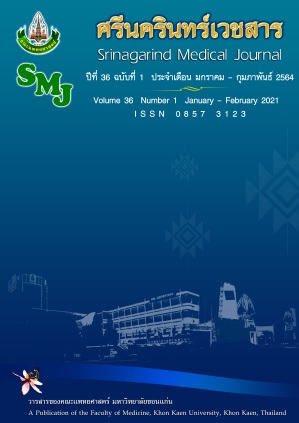The Impact of Smartphone Texting on Gait Speed in Adolescent
Keywords:
Smartphone; Waling Speed; TextingAbstract
Background and Objective: The adolescents pay attention to social media using several applications on a smartphone and are online and on their phones, texting, sharing, talking, you name it, everywhere, i.e., bedroom, bathroom, public transport or while walking etc., Even though, social media on a smartphone is a useful technology, but it also effects on physical health. Smartphone use during walking may be change gait speed. The purpose of this study was to compared walking speed during walking with use and no use smartphone in internet addict adolescent.
Methods: Twenty-five subjects aged 12-16 years old with moderate internet addict level using the internet addiction diagnostic questionnaire (IADQ) were invited in this study. All subjects were evaluated the walking speed using 10-metre walk test in two condition. Frist condition, subjects were instructed to walking without smartphone use. Second condition, subject will be texting using smartphone during their walking. The mean walking speed data was analyzed by Independent-sample T test and statistical significance was set at p < 0.05.
Results: Subjects who walking with texting using smartphone showed significant increasing in both normal comfortable walking speed (0.12 m/s increasing, p < 0.000) and maximum walking speed (0.3 m/s increasing, respectively).
Conclusions: Texting using smartphone during walking reduce gait speed in moderate internet addict adolescent. This may increase the greater risk of falls. However, future studied should be investigate in other level of internet addict adolescent.
References
2. สำนักงานสถิติแห่งชาติกระทรวงดิจิทัลเพื่อเศรษฐกิจและสังคม. National statistical Office Ministry of Digital Economy and Society. การสำรวจการมีการใช้เทคโนโลยีสารสนเทศและการสื่อสารในครัวเรือน พ.ศ. 2561 (ไตรมาส1) [ออนไลน์]. 2561 [สืบค้นเมื่อ 3 มีนาคม 2563]. จาก http://www.nso.go.th/sites/2561/FullReportICT_61.pdf
3. Sharma A, Sahu R, Kaser PK, Sharma R. Internet addiction among professional courses students: a study from Central India. Int J Med Sci Public Health. 2014; 3(9): 1069-1073.
4. วรรณคล เชื้อมงคล, ธีรวิทย์ อินทิตานนต์, จตุพร หวังเสต. ผลของการใช้สมาร์ทโฟนและเท็บเล็ต๖ฮสุขภาพและผลการเรียนของนิสิตเภสัชศาสตร์ มหาวิทยาลัยศรนครินทร์วิโรฒ. ศรีนครินทร์เวชสาร 2562; 34: 90-98.
5. Yoshiki S, Tatsumi H, Tsutsumi K, Miyazaki T, Fujiki T. Effects of smartphone use on behavior while walking. URPR 2017; 4: 138-150.
6. Rebold MJ, Lepp A, Sanders GJ, Barkler JE. The impact of cell phone use on the intensity and linkinf of a bout of treadmill exercise. PLOS [serial on the Internet. 2015 May [cited Mar 20, 2020] 1-12. Available from: https://www.ncbi.nlm.nih.gov/pmc/articles/PMC4430384/
7. Barkley JE, Lepp A. Cellular telephone use during free-living walking significantly reduces average walking speed. BMC Res Notes 2016; 9: 195.
8. เอมิกา เหมมินทร์, ปรีชา วิจิตรธรรมรส. พฤติกรรมการใช้และความคิดเห็นเกี่ยวกับผลที่ได้จากการใช้เครือข่ายสังคมออนไลน์ (Social Media) ของประชาชนในเขตกรุงเทพมหานคร. วารสารมนุษยศาสตร์และสังคมศาสตร์ มหาวิทยาลัยรังสิต 2557; 16: 120-140.
9. Parr ND, Hass CJ, Tillman MD. Cellular phone texting impair gait in able-bodied young adults. JAB 2014; 30: 685-688.
10. Adolescent health and development. Approved by Child and adolescent health unit, Department of family health gender and life course (FGL) in 2019: World Health Organization in South-East Asia / Available from: http://www.searo.who.int/entity/child_adolescent/topics/adolescent_health/en/
11. Ade D, Khare A, Kayande. Study of internet addiction in undergraduate medical students. IOSR-JDMS 2018; 17 (3): 51-55.
12. Volpini Lana MR, da Cruz dos Anjos DM, Moura Batista AC, Martind E, Oliveira de Souza KC and Leocadio RM. Comparison of reliability between a ten-metre and a one-mintue walking test in children and adolescents with cerebral palsy at mean velocity. Phys Med Rehabil 2017; 4(2): 1116.
13. Tommy Oberg, Alek Karsznia, Kurt Oberg. Basic gait parameters: Reference data for normal subjects, 10-79 years of age. J Rehabil Res Dev 1993; 30(2): 210-23.
14. Chui K, Hood E, Klima D. Meaningful change in walking speed. TGR 2012; 28(2): 97-103.
15. Clark DJ. Automaticity of walking: functional significance, mechanisms, measurement and rehabilitation strategies. Frontiers in Human Neuroscience 2015; 9: 1-13.
16. Lim J, Amado A, Sheehan L, Van Emmerik E.A. Dual task interference during walking: the effect of texting on situational awareness and gait stability. Gait & Posture 2015; 42(4): 466-71.




